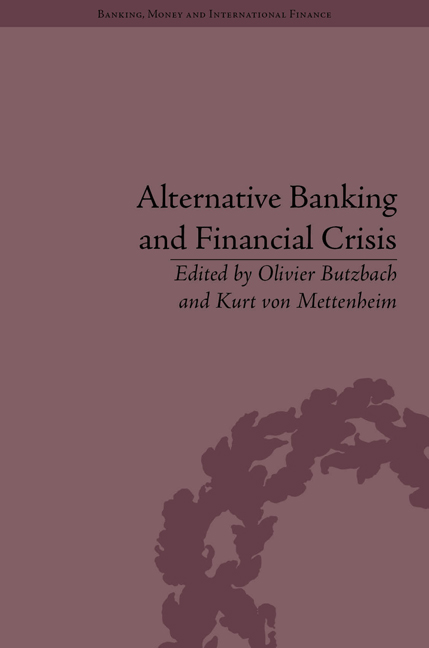Book contents
- Frontmatter
- CONTENTS
- Acknowledgements
- List of Contributors
- List of Figures and Tables
- Introduction
- Part I Historical Context and Conceptual Framework
- 1 Alternative Banking History
- 2 The Comparative Performance of Alternative Banks before the 2007–8 Crisis
- 3 The Counter-Cyclical Behaviour of Public and Private Banks: An Overview of the Literature
- 4 Explaining the Competitive Advantage of Alternative Banks: Towards an Alternative Banking Theory?
- Part II Comparative Country Cases
- Conclusion
- Notes
- Index
1 - Alternative Banking History
from Part I - Historical Context and Conceptual Framework
- Frontmatter
- CONTENTS
- Acknowledgements
- List of Contributors
- List of Figures and Tables
- Introduction
- Part I Historical Context and Conceptual Framework
- 1 Alternative Banking History
- 2 The Comparative Performance of Alternative Banks before the 2007–8 Crisis
- 3 The Counter-Cyclical Behaviour of Public and Private Banks: An Overview of the Literature
- 4 Explaining the Competitive Advantage of Alternative Banks: Towards an Alternative Banking Theory?
- Part II Comparative Country Cases
- Conclusion
- Notes
- Index
Summary
Alternative banks with social missions were founded alongside private commercial and merchant banks very early in European history. Religious orders founded savings and pawn banks throughout Italy in the fourteenth and fifteenth centuries that were often consolidated into large institutions such as the Bank of Naples in 1463. Savings banks emerged throughout Northern Europe in the late eighteenth and early nineteenth centuries. Credit cooperative were founded to avert hunger after crop failures and crisis in the late 1840s. Development banks were founded across continental Europe during the nineteenth century to accelerate industrialization and finance infrastructure. Alternative banks rapidly attained large market shares and created unique organizational structures and governance traditions to manage risk and sustain profit while serving social, political and public policy missions. This chapter reviews the historical development of competitive advantage (stakeholder governance, two-tier organizational structures, long-term profit sustainability orientations, relationship banking, greater trust, lower cost of capital) to help explain how alternative banks, where they were not privatized or demutualized, modernized to maintain or expand market shares since the liberalization of banking in the 1990s and the financial crisis in 2008.
The structure of this chapter is as follows. First, antecedents to alternative banking are reviewed in ancient Roman financial statecraft, early Christian fund management, and social and pawn banking in medieval and early modern times.
- Type
- Chapter
- Information
- Alternative Banking and Financial Crisis , pp. 11 - 28Publisher: Pickering & ChattoFirst published in: 2014



